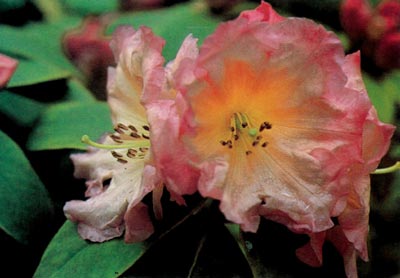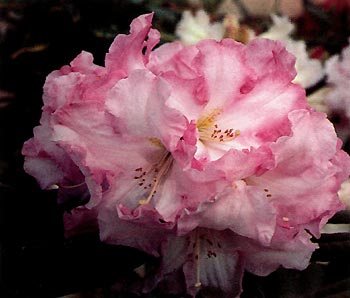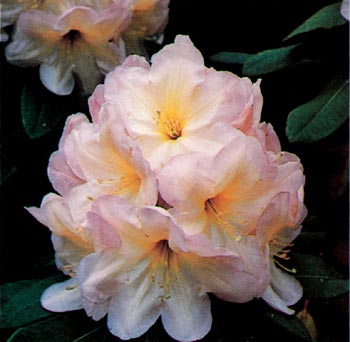JARS v38n4 - More Treasures from Lem
More Treasures from Lem
Gwen Bell, Seattle, WA
As we grow further and further removed from our pioneer generation of rhododendron hybridizers, it becomes a thrill to find a rhododendron treasure from that era standing in beautiful mature form in a private garden, raised from a seedling, unregistered and, perhaps, un-propagated - or an unfamiliar Lemism.
Not so long ago, Dorothy Larson was reminiscing about her acre of garden on Mercer Island. She had looked out on tall, free flowering rhododendrons and recalled digging them out of the multitude of flats that Halfdan Lem lined out each year. Tiny seedlings with impressive pedigrees. One of her favorite and slightly sentimental memories occurred years ago when a friend asked Dorothy to accompany her on a purchasing expedition to the Lem Nursery. Dorothy had felt for some time an obligation to repay favors given her by this friend, so she seized this chance to repay that debt. She called Lem telling him that she wished to give a $100 gift of plants and "Please refuse money from my friend." Halfdan Lem thought this a novel and thoroughly satisfactory idea. Later, as the two ladies dug out the little individual rhododendrons, Lem would say, "Dig another one" or "Take those two little ones left over there." When it was time to pay the bill, at 75¢ a plant, there were more seedlings than even $100 would buy. I'm sure that Lem had known that there would be. He insisted that Dorothy should not go home empty handed and pushed all the excess plants to her. She had not been prepared for such a great number of little rhododendrons, but she walked determinedly out into her woods, sank a sort of wire fence into the ground to frustrate the moles and watered in the baby plants. Most of them survived and grew, competing successfully with native trees and groundcovers. Eventually, they became crowded on that acre. It is not surprising that some of those diverse little seedlings have become her most favorite flowering shrubs.
One of the loveliest of her favorites is a light yellow, round trussed flower on a slow to medium growing plant. It has exceptionally beautiful smooth and rounded foliage. Parentage has been lost, but it is probably a R. wardii hybrid.
Another favorite produces huge paper white blooms with two rays of red spots flaring out on the upper lobes. It is fragrant and has a smooth, medium to light green leaf, blooms early and is, unfortunately, difficult to propagate. This rhododendron was dug from a flat labeled 'Lem's Goal' x 'Loderi King George'.
'Anna' x 'Loderi King George' displays large closed trusses of medium pink color, intensified by a red eye in the throat. Kind of makes me think of luscious things like ice cream sodas.
Especially interesting is a rhododendron seedling that has been stubbornly slow to grow. Its blooms glow yellow in the throat, pink on the deep margins and it is backed by a calyx as wide as the corolla, making it appear double. I asked her if she had thought of naming this little favorite. She responded with a laugh, "Just call it Double Dare."

|
|
Double Dare
Photo by Gwen Bell |
When Lem's seedling W14 bloomed, she took a truss to the nursery to show it to Lem. He had enjoyed seeing what his seedling crosses produced. To her chagrin, Lem repudiated the orange pink, late flowering, fuzzy and reddish leafed rhododendron. He declared emphatically that he had never used the number W14. Puzzled, she consulted her friend and found that she, too, was growing a plant labeled W14. Mystery!
June Sinclair of the Seattle Chapter smiles over the memory of her youngest son transporting three rhododendrons the two miles from the Lem Nursery on his skateboard. A fitting gift for Mothers' Day. Those three plants were what Mrs. Lem used to call "one legged" plants. Each stretched tall, un-branched, taller than the skateboard enthusiast. And since each rhododendron cost only $1.00, they were just about right for his monetary resources. One of these rhododendrons was tagged as 'Lem's Fluorescent Pink'. June was surprised when the buds opened to round trusses of pink and white, a satiny bicolor. It proved to be free flowering and late, fragrant and easy to propagate.

|
|
Lem's Fluorescent Pink
Photo by Gwen Bell |
A neighbor to June and Jim Sinclair was a close friend of Halfdan Lem. When his daughter married, he borrowed a large number of blooming rhododendrons from Lem. Walking down their road, one was almost stunned by the vivid display of colors shimmering in the spring sunshine. Rhododendron bushes in full bloom bordered both sides of the drive. The next day, however, the show was gone, the driveway was bare. The neighbor had returned his borrowed instant landscape.
Have you ever heard of a cocktail made of whiskey and strawberry pop? Still in shock, that neighbor told the Sinclairs that he watched as Lem retrieved his whiskey bottle from its hiding place near the door of the potting house and before unbelieving eyes, poured a large dollop of whiskey into a glass of strawberry pop. Politely he offered the glass to his guest. For a man who liked his whiskey neat, it was quite a shock.
Another of the "one legged" rhododendrons has a rather curious way of opening its flower buds. The truss has three tiers of individual flowers. The lower tier expands first, then the next row and, finally, the top tier. At last, the full flower is open, peachy orange in color, tubular, upright in habit and a late bloomer. What Lem used as parents is not known. It propagates without difficulty but has never been named, tested or registered. Another Lem treasure.
Loyd Newcomb, Seattle Chapter...Before moving to Seattle, I did not know of the existence of rhododendrons. By 1960, I had not only discovered the existence of rhododendrons but, also, that they could be readily grown from seed. The next logical step was to start hybridizing (somewhat blindly I must admit). Probably my most significant discovery, however, was that I lived less than one half mile from Halfdan Lem. Seeing his garden for the first time was the opening of a new world for me. During the course of many visits, we became more than casual acquaintances. I told him of my first efforts at hybridizing ('Van Nes Sensation' x 'Purple Splendor') and he bluntly said I should go home and throw them away because they wouldn't be anything but lavender and nobody would want them. At that time, he felt that any cross that didn't have a potential in the yellow or orange color range wasn't worth growing. During the years 1964 through 1968, he supplied me with enough seeds and sprouted seedlings to plant ten acres. Fortunately, I learned the necessity of culling plants before getting the entire ten acres planted.
To me Lem was very generous and helpful. I acquired a great deal of knowledge from him as well as many valuable rhododendrons. In 1984, I am still continuing with hybridizing some of the better hybrids Lem developed.
One of the most striking hybrids to come from our garden is one of Lem's crosses, 'Holy Moses' x 'Albatross', which we have registered as 'Moonwax'. I regret that Lem was not able to know of it and that it has received a Conditional Award of Merit. He would have been pleased.

|
|
'Moonwax'
Photo by Edna Newcomb |
Eddie (Edna) Newcomb...When Loyd wrote to Lem about planting the 5000 Acer palmatum dissectum seeds that Lem had ordered for Loyd from Italy, Loyd was asking about mold, as in damping off. Lem's interpretation was apparently just as he pronounced mole (as in the little burrowing bugger). Lem's accent and style of speech was strongly Norwegian. So he went to great lengths to tell Loyd how to foil the moles! We never did get his opinion on how he dealt with damp-off and, of course, a lot of those maple seedlings did die from damp-off. It was funny anyway - he was a great guy.
Excerpt from Lem's letter to Loyd Newcomb dated February 14, 1968.
"Your maple seeds look real good. They have already started to swell. I have taken them out from the freezer for two nights and then leave them on the kitchen table where it keeps quite warm all night. This makes them to swell and soften up a little more each time. But we can't keep on doing this very long. Because they may split the shell and the inside may rot. So later February as you say, should be bout the right time for you to come get them. I'm glad to know you will have your frame ready.
But I got a little scared when you say the molds bother you. In that case you got to have small mashed chicken netting underneath your frame so no molds get in there and destroy everything for you. It costs so very little anyway and it will last for 23 years. The netting should then be 5-6 inches deep in the ground so the molds don't push it up and disturb the seed. You understand what I mean. Just nail the netting on the frame underneath and then put 4 inches of good soil on top of the netting. There on you plant the seed and again another inch of peat moss and sand to cover the seed with. This way almost every seed sprouted with me. Not all seeds are fertile, but you will get a few thousand seeds when you come. All you need. Will see you soon."
Sincerely, Halfdan Lem
Halfdan Lem was truly one of the pioneers in hybridizing rhododendrons. What a foundation he has left us to further our goals in the future!
